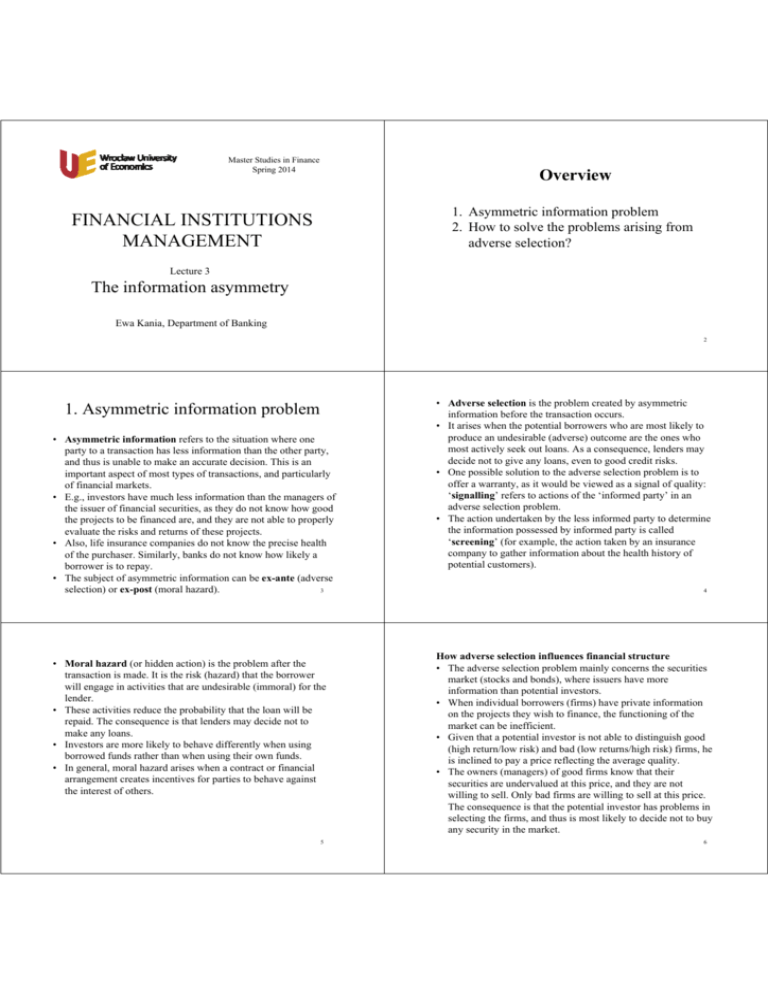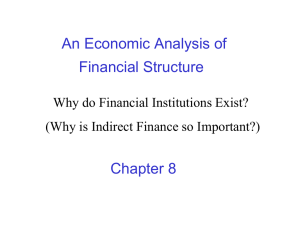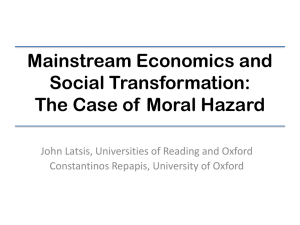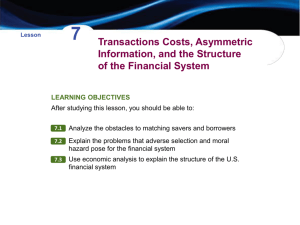FINANCIAL INSTITUTIONS MANAGEMENT
advertisement

Master Studies in Finance Spring 2014 Overview 1. Asymmetric information problem 2. How to solve the problems arising from adverse selection? FINANCIAL INSTITUTIONS MANAGEMENT Lecture 3 The information asymmetry Ewa Kania, Department of Banking 2 1. Asymmetric information problem • Asymmetric information refers to the situation where one party to a transaction has less information than the other party, and thus is unable to make an accurate decision. This is an important aspect of most types of transactions, and particularly of financial markets. • E.g., investors have much less information than the managers of the issuer of financial securities, as they do not know how good the projects to be financed are, and they are not able to properly evaluate the risks and returns of these projects. • Also, life insurance companies do not know the precise health of the purchaser. Similarly, banks do not know how likely a borrower is to repay. • The subject of asymmetric information can be ex-ante (adverse selection) or ex-post (moral hazard). 3 • Moral hazard (or hidden action) is the problem after the transaction is made. It is the risk (hazard) that the borrower will engage in activities that are undesirable (immoral) for the lender. • These activities reduce the probability that the loan will be repaid. The consequence is that lenders may decide not to make any loans. • Investors are more likely to behave differently when using borrowed funds rather than when using their own funds. • In general, moral hazard arises when a contract or financial arrangement creates incentives for parties to behave against the interest of others. 5 • Adverse selection is the problem created by asymmetric information before the transaction occurs. • It arises when the potential borrowers who are most likely to produce an undesirable (adverse) outcome are the ones who most actively seek out loans. As a consequence, lenders may decide not to give any loans, even to good credit risks. • One possible solution to the adverse selection problem is to offer a warranty, as it would be viewed as a signal of quality: ‘signalling’ refers to actions of the ‘informed party’ in an adverse selection problem. • The action undertaken by the less informed party to determine the information possessed by informed party is called ‘screening’ (for example, the action taken by an insurance company to gather information about the health history of potential customers). 4 How adverse selection influences financial structure • The adverse selection problem mainly concerns the securities market (stocks and bonds), where issuers have more information than potential investors. • When individual borrowers (firms) have private information on the projects they wish to finance, the functioning of the market can be inefficient. • Given that a potential investor is not able to distinguish good (high return/low risk) and bad (low returns/high risk) firms, he is inclined to pay a price reflecting the average quality. • The owners (managers) of good firms know that their securities are undervalued at this price, and they are not willing to sell. Only bad firms are willing to sell at this price. The consequence is that the potential investor has problems in selecting the firms, and thus is most likely to decide not to buy any security in the market. 6 • These asymmetries impede the functioning of financial markets: they can either obstruct the conclusion of transactions (and cause the collapse of the market), or influence the level (and the quality) of production activities. • Although the existence of organised financial markets partially reduces some of these problems, the solution to them has been the emergence of financial intermediaries. • The adverse selection problem explains one empirical fact: why marketable securities – and stocks in particular – are not the primary source of external financing for firms. 7 Principal–agent problem • This is also related to the problem of incentive structures. The problem arises because the agent often has superior information and expertise (which may be the reason the principal employs them). • Agency problems also arise because the agent cannot be efficiently or costlessly monitored. The agency costs involved can act as a serious deterrent to financial contracting with resultant losses. The challenge is to create financial contracts that align the interests of the principal and the agent. • A typical example of principal–agent problem refers to a situation of separation of ownership and control in a firm. Managers (the agents) may act in their own interest rather than in the interest of shareholders (the principals) because the managers have less incentive to maximise profits than shareholders. 8 2. How to solve the problems arising from adverse selection? • Full information on the borrowers should be provided to the lenders. The following tools can be used: A. Private production and sale of information B. Government regulation C. Financial intermediaries A. Private companies can produce and sell the information needed to distinguish good and bad firms and to select their securities. E.g., S&P’s categorises corporate bond issuers into major classes according to perceived credit quality. The first four quality ratings – AAA, AA, A, BBB – indicate quality investment borrowers. 9 B. Governments take steps to ensure that firms disclose full information to potential investors. In fact, financial markets are among the most heavily regulated sectors in the economy. • In the U.S., the Securities and Exchange Commission is the government agency entrusted to promote the adherence to standard accounting principles and disclosure of information. • However, disclosure requirements do no solve the adverse selection problem, as the collapse of the Enron Corporation demonstrates. 11 • Adverse selection is not completely solved by the private production and sale of information because of the free-rider problem. This occurs when people who do not pay for information take advantage of information acquired by other people. • If you buy the information on the quality of firms, you can use it to purchase undervalued securities of good firms. However, other investors who have not purchased the information, may observe your behaviour and buy the same security at the same time. • The increase in the demand for the undervalued security will cause a build-up in its price to the true value. The effect is to negate the value of information. • The free-rider problem explains why investors are reluctant to buy information. Thus the adverse selection problem remains. 10 C. Financial intermediaries, and especially banks, produce more accurate valuations of firms and are able to select good credit risks thanks to their expertise in information production. • One advantage of banks is that they can have information about potential borrowers from the transactions on their bank accounts: banks obtain a profile of the suitability for credit (and ability to repay the loan) from the accounts of their customers. • By acquiring funds from depositors and lending them to good firms, banks earn higher returns on their loans than the interest paid to their depositors. • Banks are able to avoid the free-rider problem because their loans are private securities, not traded in the open financial market. 12 • Moral hazard in debt contracts is lower than in equity contracts but still present. Debt contracts require borrowers to pay fixed amounts and let them keep any profit above this amount. Consequently, borrowers have incentives to take investments riskier than lenders would like. • Moreover, banks reduce the adverse selection problem by asking the borrower to provide collateral against the loan. Collateral is property promised to the lender if the borrower defaults. Thus, it reduces the losses of the lender in the event of a default. • Therefore, financial intermediaries solve the adverse selection problem, whereas the private production of information and government regulation only reduce it. • The presence of adverse selection explains: • How to reduce/solve the problems arising from moral hazard in equity markets? • Several tools can be used: 1. why bank loans are the most important source of funds raised externally, 2. why indirect finance is more important than direct finance. 13 A. Stockholders can engage in the monitoring (auditing) of firms’ activities to reduce moral hazard. Monitoring is needed: • to ensure that information asymmetry is not exploited by one party at the expenses of the other, • because the value of equity contracts cannot be certain when the contract is made, • because the value of many financial contracts (i.e., future return on a stock) cannot be observed or verified at the moment of purchase, and the post-contract behaviour of a counterparty determines the ultimate value of the contract, • the long-term nature of many financial contracts implies that information acquired before the contract is agreed may become irrelevant at the maturity due to changes in conditions. 15 C. Financial intermediaries operating in the equity market are able to avoid the free-rider problem in the face of moral hazard. Venture capital firms use the funds of their partner firms to help entrepreneurs to start new businesses; in exchange for the use of the venture capital, the firm receives an equity share in the new business. • Venture capital firms have their people participating in the management of the firm (i.e., easier profit verification and thus lower moral hazard). • Moreover, the equity in the firm is not marketable to anyone but the venture capital firm (i.e., elimination of the free-riding of other investors). 17 A. Monitoring B. Government regulation to increase information C. Financial intermediaries active in the equity market D. Debt contracts 14 • Monitoring is expensive in terms of money and time (a costly state verification). If you know that other stockholders are paying to monitor the activities of the firm you hold stocks in, you can free ride on the activities of the others. • As every stockholder can free ride on others, this reduces the amount of monitoring that would reduce the moral hazard (principal–agent) problem. This is the same as with adverse selection and makes equity contracts less desirable. B. Governments have incentives to reduce the moral hazard problem. Several measures are used: laws to force firms to adhere to standard accounting principles (i.e., to make profit verification easier); laws to impose penalties on people who commit the fraud of hiding/stealing profits. 16 D. Debt contracts are a way to reduce moral hazard. Moral hazard affects equity contracts because they are claims on profits in all situations, whether the firm makes or loses money. Consequently, there is the need to structure a contract that confines moral hazard to certain situations, and reduces the need to monitor managers. • This is a contractual agreement to pay the lender a fixed amount of money independently from the profits of the firm. Hence, debt contracts are preferred to equity contracts. The presence of moral hazard in equity markets explains why stocks are not the most important external source of financing for firms. 18 How to reduce/solve the moral hazard problems in debt markets? • Although debt contracts reduce the amount of moral hazard in comparison to equity contracts, they do not solve the problem. Borrowers have incentives to take investments riskier than lenders would like: borrowers get all the gains from a risky investments if they succeed, but lenders lose most, if not all, of their loan, if borrowers fail. • The solution to the problems of moral hazard lies again in financial intermediaries. However, other tools also can be used: A. making debt contract incentive–compatible (i.e., aligning the incentives of borrowers and lenders), B. monitoring and enforcement of restrictive covenants. 19 2. Those which encourage desirable behaviour from the lender’s point of view. One example is a mortgage loan with a provision that requires the borrower to purchase life insurance that pays off the loan in the event of the borrower’s death. 3. Covenants that keep collateral valuable. 4. Covenants that provide information about the activities of the borrowing firm, such as quarterly accounting and income reports. The presence of covenants reduces moral hazard problems and explains why debt contracts are often complicated legal documents. 21 • Banks have a comparative advantage relative to direct lending in monitoring activities in the context of costly state verification. In fact, they have a better ability to reduce monitoring costs because of their diversification. • Several conditions are required for delegated monitoring to work: – existence of scale economies in monitoring, i.e., a typical bank finances many projects, – small capacity of investors as compared to the size of investments, i.e., each project needs the funds of several investors, – low cost of delegation, i.e., the cost of monitoring the financial intermediary itself has to be less than the surplus gained from exploiting scale economies in monitoring investment projects. 23 A. Investors are more likely to take on riskier investment projects when using borrowed funds than when using their own funds. Thus the moral hazard problem can be reduced by increasing the stake of personal net worth (the difference between personal assets and liabilities). B. A restrictive covenant is a provision aimed at restricting the borrower’s activity. There are four types of possible covenants: 1. Those which discourage undesirable behaviour by the borrower (i.e. not to undertake risky investment projects). Examples: – to use the debt contract only to finance specific activities, such as the purchase of a fixed asset; – to prohibit the firm from issuing new debt, or disposing of its assets; – to restrict dividend payments if some ratios have not reached a critical level; – to limit purchases of major assets or merger activities. 20 • Covenants do not eliminate moral hazard problems: it is not possible to rule out every risky activity. Moreover, covenants must be monitored and enforced. Monitoring typically involves increasing returns to scale, which implies that it is more efficiently performed by specialised financial institutions. Individual lenders tend to delegate the monitoring activities instead of performing them directly. Thus the monitor has to be given an incentive to do its job properly. • However, because monitoring and enforcement are costly, investors can free-ride on those activities undertaken by other investors. Thus in the bond market (as well as in the stock market) the freerider problem arises. The consequence will be that insufficient resources will be devoted to these activities. • Financial intermediaries, and especially banks, can be seen to provide solutions both to the incentive problem and to the free-rider problem. 22 Note: 1. Stocks are not the most important source of external financing. 2. Marketable securities are not the primary source of finance. 3. Indirect finance is more important than direct finance. 4. Banks are the most important source of external funds. 5. The financial system is heavily regulated. 6. Only large, well-established firms have access to securities markets. 7. Collateral is prevalent in debt contracts. 8. Debt contracts have numerous restrictive covenants. 24






